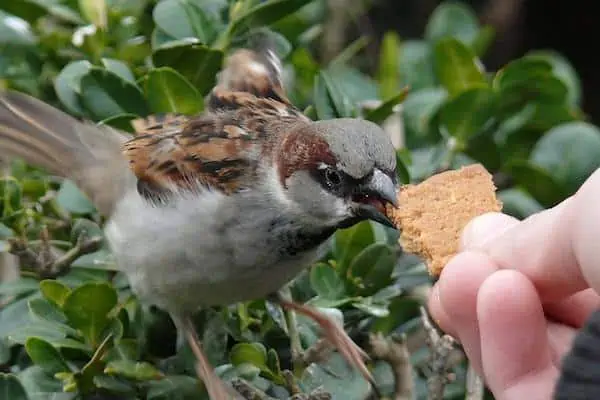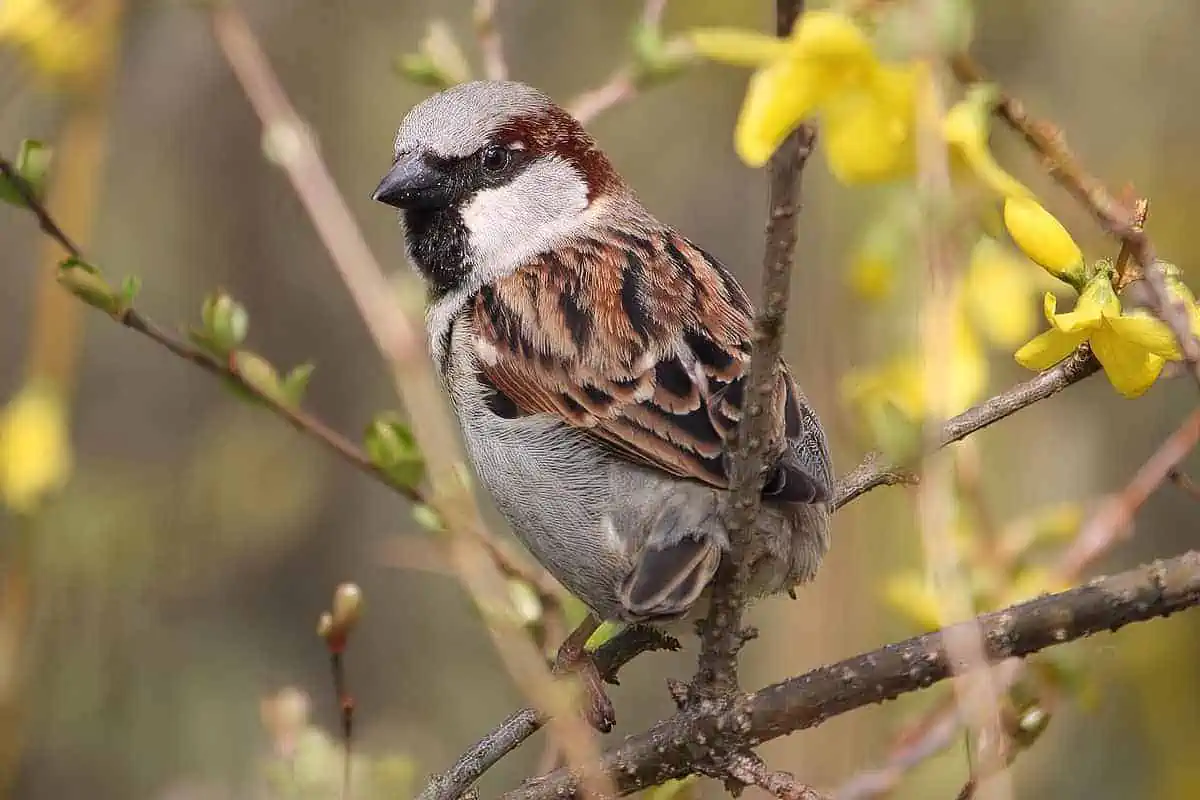These little brown birds are very common. House sparrows are ubiquitous, from your backdoor feeders to the grocery store lot to nesting inside shopfront lettering outside shopping malls. They are also citizens of the United States. Yet, almost every other continent! Let’s learn a little about house sparrows and how they adapt to their surroundings.
FACTS ABOUT HOUSE SPARROWS
Despite its small size, the House Sparrow is massive in terms of population and geographical dispersion. The House Sparrow is a species that can live in both urban and rural environments.
Let’s dive into more fun facts.
1. HOUSE SPARROWS ARE THE MOST WIDELY DISTRIBUTED WILD BIRD IN THE WORLD
Except for Antarctica, House Sparrows may be found on every continent! This puts the species in the Guinness World Records for having the most global distribution. House Sparrows were introduced to North and South America, Africa, and Australia either on purpose or by accident. They are native to most of Europe, the Mediterranean, and a big part of Asia.
2. HOUSE SPARROWS ENTERED THE UNITED STATES TO COMBAT A PEST
The House Sparrow was first introduced to the United States in 1851, although it is now a very frequent species. In the early 1850s, linden moth caterpillars infested trees all over New York City.
Since the house sparrows eat them, they were brought in from Europe to Brooklyn to help battle the pests. It did the trick, but it was a little too successful. House sparrows, which were released in New York and other places, spread across the United States within 50 years.

3. HOUSE SPARROWS HAVE A LIFE EXPECTANCY OF 4-5 YEARS IN THE WILD AND UP TO 12 YEARS IN CAPTIVITY
In the wild, a house sparrow has a lifespan of around five years, but in captivity they have been known to live twice as long. In the wild, however, some individuals may reach a ripe old age. A 15-year-old house sparrow was discovered in Texas and was the oldest known.
4. THE HOUSE SPARROW ISN’T RELATED TO OTHER AMERICAN SPARROWS
These sparrows are originally from Europe, as we’ve previously stated. As a result, their unusual form cannot be traced back to other North American sparrows. With a bigger, more rounded head, shorter tail, stockier build, and bulkier body than native sparrows, house sparrows are “chunkier.”
5. MALES AND FEMALES HAVE DIFFERENT PLUMAGE
The bill of breeding males is black, and the eyes, under their bill, and in a rounded “bib” on their chest are all black. Gray on their belly and head, with white cheeks and a chestnut brown neck and wings with black flecks. Non-breeding males have a beak that is yellow and a chest that is less black.
Plain light brown with grayish underparts and striped backs, females are a plain light brown all over.
6. LARGER BLACK BIBS CAN INDICATE OLDER MALES
Knowing who is the highest in the pecking order is critical for birds that live in groups. Feathers are a simple way to communicate this information while preventing confrontations. Older and more domineering males with bigger black chests on their chests tower over males with lesser black chest patches.
7. HOUSE SPARROWS ARE CONSIDERED EXTREMELY SOCIAL
These sociable birds will form flocks with any other species and are considered to be exceedingly social. Sparrow nests will feed on the ground with other sparrows and are commonly found in big clumps with other sparrows.
According to reports, this bird species is exceedingly sociable, and it may even feed from your hand.
8. HOUSE SPARROWS HAVE PHYSICAL CUES THEY USE WITH EACH OTHER TO INDICATE DOMINANCE
House Sparrows have developed several signals that they use with each other to determine who is dominant and who is submissive since they tend to dwell in these groups. Tails may be flicked, crouched, and spread wings may be lifted, wigs might be raised fully and all feathers might be puffed out.
During the winter months, males are typically in charge of females, but females will push back and become more forceful throughout the spring and summer.

9. HOUSE SPARROWS ARE OMNIVORES AND WILL EAT JUST ABOUT ANYTHING
Seeds and little insects are common foods for House Sparrows, but they have also been known to consume discarded human meal and trash meal. They’re frequently seen hovering around outdoor eateries and patios, looking for dropped crumbs and french fries.
A House Sparrow’s diet is mostly determined by its environment. Crops such as corn, wheat, oats, and sorghum may be included, as well as wild foods like grasses, ragweed, and buckwheat. They are particularly fond of sunflower, milo, and millet seeds that are offered at bird feeders. House Sparrows may wait for insects to gather around lights after dark and catch them in the air.
10. HOUSE SPARROWS SPEND A LOT OF TIME ON THE GROUND
Whether they are hunting for crumbs of human food or wild seeds, these birds prefer to forage on the ground. House Sparrows hop rather than walk when on the ground, unlike other birds.
11. HOUSE SPARROWS WILL OFTEN TAKE DUST BATHS
The House Sparrow performs a social activity known as dust bathing, which involves groups on dusty and dry ground patches. Parasites or other harmful materials may be removed from their plumage, feathers, or skin using this method.
They perform the identical actions, but instead of bathing in water, they soil themselves. Afterwards, they may defend this location and thus prevent other sparrows from utilizing it, leaving a tiny depression in the earth.
12. MAN-MADE STRUCTURES ARE A FAVORITE FOR NESTING
These sparrows are particularly fond of nesting in human-made constructions, which is one adaptation that has made them comfortable in cities. Gutters, barns, street lights, birdhouses, and other items such as ceiling ledges and traffic lights They will even nest in the signs outside of bustling retail malls, and they don’t seem to mind being in very close proximity to humans.
13. HOUSE SPARROWS ARE CLOSELY ASSOCIATED WITH PEOPLE AND HUMAN ACTIVITY
House Sparrows are less common outside in rural wooded areas or empty grasslands. In cities, towns, farms, and suburban neighborhoods, they prefer to be near human activity.
14. HOUSE SPARROWS SOMETIMES DISPLACE OTHER BIRDS OUT OF NEST BOXES
Sadly, if these birds decide to use your backyard birdhouse, they may be quite aggressive even if another bird is already in there. As a consequence of the invasion, bluebirds, wrens, tree swallows, and other birds will be forced out of the home and unable to re-enter.
They might even collide and hurt the other bird. As a result, many backyard bird lovers consider them to be a pest and dislike them. In reality, a lot of individuals have legitimate reasons to loathe these birds.
15. THERE ARE 12 SUBSPECIES AROUND THE WORLD
There are at least 12 distinct subspecies identified right now, with slight differences in size and appearance seen across diverse geographical areas.
